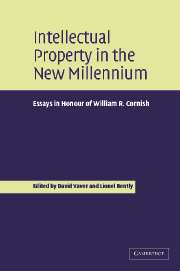Book contents
- Frontmatter
- Contents
- List of contributors
- Foreword
- Preface
- General intellectual property
- Patents and plant protection
- 5 Creating the community patent and its court
- 6 Patents – what's invention got to do with it?
- 7 Common law and civil law approaches to patent claim interpretation: ‘fence posts’ and ‘sign posts’
- 8 Indirect infringement of patents in Israel: judge-made law
- 9 Genomics and the food industry: outlook from an intellectual property perspective
- 10 From ‘outmoded impediment’ to global player: the evolution of plant variety rights
- Trade marks and unfair competition
- Copyright, moral and neighbouring rights
- William R. Cornish – curriculum vitae
- Index
8 - Indirect infringement of patents in Israel: judge-made law
Published online by Cambridge University Press: 25 May 2010
- Frontmatter
- Contents
- List of contributors
- Foreword
- Preface
- General intellectual property
- Patents and plant protection
- 5 Creating the community patent and its court
- 6 Patents – what's invention got to do with it?
- 7 Common law and civil law approaches to patent claim interpretation: ‘fence posts’ and ‘sign posts’
- 8 Indirect infringement of patents in Israel: judge-made law
- 9 Genomics and the food industry: outlook from an intellectual property perspective
- 10 From ‘outmoded impediment’ to global player: the evolution of plant variety rights
- Trade marks and unfair competition
- Copyright, moral and neighbouring rights
- William R. Cornish – curriculum vitae
- Index
Summary
Historical background
Traditionally, the doctrine of contributory or indirect infringement has not been an integral part of Israeli patent law. More correctly, it has never been recognized as such by the Israeli legislator. This is mainly due to the fact that Israeli patent law derives from English patent law since the British Mandatory Ordinance of Patents and Designs 1924, substituted by the Israeli Patents Act 1967.As is well known, English common law did not include an indirect infringement prohibition until the Patents Act 1977. The introduction of indirect infringement into UK law resulted from the need to adapt national laws to the provisions of the Community Patent Convention 1975 (CPC). The Israeli legislator was probably influenced by the common law's negative attitude towards indirect infringement, thus ignoring creative efforts by Israeli courts to adopt such a doctrine. This attitude could be justified in the past, as long as Israel was considered to be a developing country. Such countries normally oppose the granting of strong rights in patents, as patents are registered in most cases by foreign enterprises in order to prevent competition by local industry.
Section 49 of the Israeli Patents Act 1967 (prior to the 1998 amendment discussed below) defined the term ‘infringement’ by conferring on the patentee the right to prevent all third parties not having his consent from exploiting the patented invention.
- Type
- Chapter
- Information
- Intellectual Property in the New MillenniumEssays in Honour of William R. Cornish, pp. 109 - 123Publisher: Cambridge University PressPrint publication year: 2004



